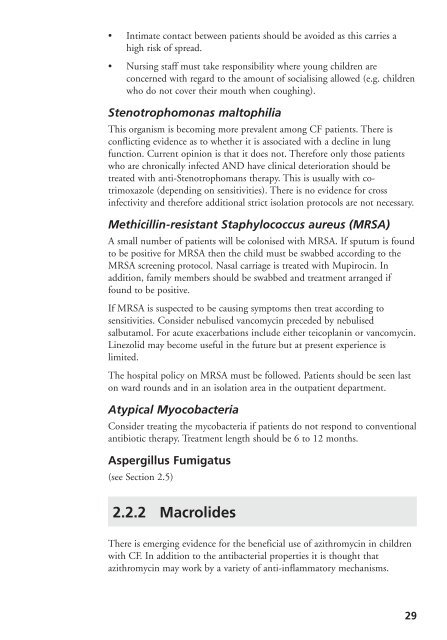Section 10 - Cystic Fibrosis Clinical Care Pathway
Section 10 - Cystic Fibrosis Clinical Care Pathway
Section 10 - Cystic Fibrosis Clinical Care Pathway
You also want an ePaper? Increase the reach of your titles
YUMPU automatically turns print PDFs into web optimized ePapers that Google loves.
• Intimate contact between patients should be avoided as this carries a<br />
high risk of spread.<br />
• Nursing staff must take responsibility where young children are<br />
concerned with regard to the amount of socialising allowed (e.g. children<br />
who do not cover their mouth when coughing).<br />
Stenotrophomonas maltophilia<br />
This organism is becoming more prevalent among CF patients. There is<br />
conflicting evidence as to whether it is associated with a decline in lung<br />
function. Current opinion is that it does not. Therefore only those patients<br />
who are chronically infected AND have clinical deterioration should be<br />
treated with anti-Stenotrophomans therapy. This is usually with cotrimoxazole<br />
(depending on sensitivities). There is no evidence for cross<br />
infectivity and therefore additional strict isolation protocols are not necessary.<br />
Methicillin-resistant Staphylococcus aureus (MRSA)<br />
A small number of patients will be colonised with MRSA. If sputum is found<br />
to be positive for MRSA then the child must be swabbed according to the<br />
MRSA screening protocol. Nasal carriage is treated with Mupirocin. In<br />
addition, family members should be swabbed and treatment arranged if<br />
found to be positive.<br />
If MRSA is suspected to be causing symptoms then treat according to<br />
sensitivities. Consider nebulised vancomycin preceded by nebulised<br />
salbutamol. For acute exacerbations include either teicoplanin or vancomycin.<br />
Linezolid may become useful in the future but at present experience is<br />
limited.<br />
The hospital policy on MRSA must be followed. Patients should be seen last<br />
on ward rounds and in an isolation area in the outpatient department.<br />
Atypical Myocobacteria<br />
Consider treating the mycobacteria if patients do not respond to conventional<br />
antibiotic therapy. Treatment length should be 6 to 12 months.<br />
Aspergillus Fumigatus<br />
(see <strong>Section</strong> 2.5)<br />
2.2.2 Macrolides<br />
There is emerging evidence for the beneficial use of azithromycin in children<br />
with CF. In addition to the antibacterial properties it is thought that<br />
azithromycin may work by a variety of anti-inflammatory mechanisms.<br />
29


